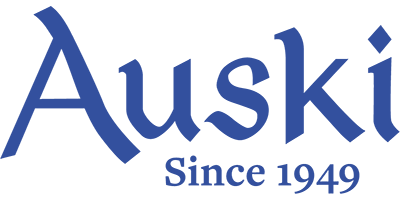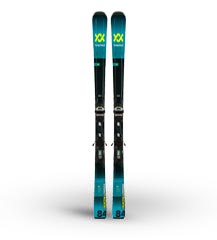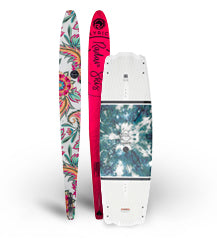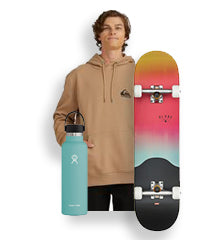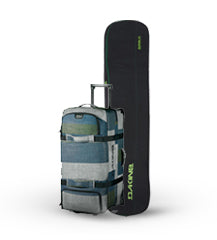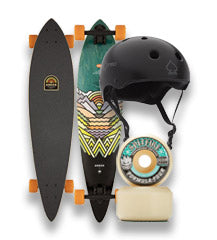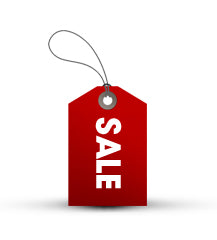Snowboards Shape & Flex
March 13, 2024 10 min read
Snowboard Shapes & Flex Explained
snowBoard Shapes
The feel of a snowboard is heavy determined by the board’s shape. Board shapes will either benefit the rider or hinder a riding depending on what type of terrain is being ridden. Freestyle boards designed for jibs, jumps, and halfpipe are generally a True Twin shape, where as most all mountain, freeriding, and powder boards have a Directional or Directional Twin / Twin Like shape.
Directional
Most common among freeride snowboards and sometimes found on all-mountain boards, the directional shape is a non-symmetrical construction designed to be mostly ridden in one direction. This means that they have a specified nose and tail; each end may differ in stiffness, shape and contact points.
The nose is typically longer and wider than the tail, which helps with floatation in powder and stability at speed. The bindings are often set back towards the tail, enhancing turning leverage and powder performance.
True Twin
Although this shape can be found on just about all board types, true twin dominates the freestyle scene. True twin, also known as twin tip, means that the tip and tail are identical. The symmetrical shape allows park, pipe, and street riders to perform and land technical switch tricks easier.
True twin boards open up a whole new window for freestyle snowboarders. Both ends of the board (nose and tail) are identical in shape and length, with symmetrical flex patterns. The bindings are centred on the board.
Directional Twin
Commonly found in all-mountain boards, the directional twin shape is a great all-around board choice. Directional twin consists of a nose and tail that are different in construction. Although the tip and tail might not be exactly the same, riders may ride switch in the park or pipe without noticing any negative effects.
The Directional Twin features a symmetrical shape like a twin for balance and ease of switch riding but often has a directional flex pattern—stiffer towards the tail for stability at speed and softer in the nose for maneuverability.
Snowboard Profile Shapes
Snowboard Profile Shape refers to the side profile of an un-weighted board on a flat surface. Looking at the board from the side you can roughly decipher what Profile Shape a board has. There are several types of Profile Shapes, all with their own purpose to help improve a rider’s performance. The information below is to be used as reference to help you decide what Profile Shape is the best fit for your riding style.
Camber Profile
Camber is the tried-and-true standard for a snowboard profile. It is still the most popular camber style and will probably be around forever. A traditionally cambered board has a smooth arch underneath the middle of the board that comes down and touches the ground near the tip and tail when no additional weight is applied. When a rider straps into a cambered board, the board flattens out on the snow and creates an evenly applied pressure to the edges. This camber profile provides explosive pop and strong edge hold making it good for all types of riding.
Rocker Profile
The Rocker profile has become extremely popular among freestyle riders and powder-hounds alike. This profile is the exact opposite of a traditional camber. It consists of a single central contact point that when weighted, flexes to create less edge contact on the tip and tail for easy pivoting action and all-day playfulness. The rocker is also a more forgiving camber style when landing spins, jibs and other tricks. Less edge contact means less hang up on the lips and landings. Freeride snowboarders like the rocker profile because they create a surfy feel in powder, allowing you to really slash and put up a wall of white like you’re riding the curl.
Flat Profile
A Flat board profile is another great option for progressive riders. The completely flat shape is implemented from near the tip to near the tail and is a versatile design. This profile has the forgiveness and butter-like characteristics of a rocker board, but with precise edging capabilities similar to that of a traditional camber. This camber profile is ideal for freestyle riding and is usually found in the park or street. The flat camber profile may not be the fastest board design, but it isn’t made to be raced, it’s meant to deliver a skate-inspired feel for a fun time dropping hammers.
Hybrid Profiles
These generally consist of any snowboard design that combines two or more traditional profile shapes (camber, rocker, and flat) into one board. The aim is to capture the benefits of each profile in different sections of the board—for example, camber underfoot for pop and edge hold, with rocker towards the tips for float in powder and forgiveness in turns. There are many variations of hybrid profiles, including rocker-camber-rocker, camber-rocker-camber, and others, depending on the order and extent of each profile type used.
To learn more about Cambers, read our guide to Snowboard Cambers Explained.
Powder Profile - Powder Camber / Rocker / Flat Combination Profile
Riding powder is an exceptional experience, especially for those who don't often have the opportunity. To significantly enhance this experience, using a snowboard specifically tailored for powder conditions is key. Most Powder Combination Profile Shapes feature an enlarged scooping nose, larger than that of Rocker Profile Shapes, extending from the bindings to the tip. This design effortlessly lifts the board's front, ensuring optimal floatation. The remainder of the board typically adopts either a flat, cambered, or a hybrid profile.
The cambered section, with its arching curve in the board's center, offers a lively, springy sensation. This not only boosts responsiveness and edge grip on firmer snow but also distributes pressure effectively in powder, aiding in floatation. On the other hand, a flat profile ensures stability and balance, making it exceptional for cruising through deep snow. This configuration allows the board to float seamlessly, maintaining the nose above the snow while the tail slightly sinks, facilitating dramatic slashes and agile turns in powder.
3-Stage Profile
This is a more specific term that usually describes a board with three distinct zones: a central flat section flanked by two cambered areas towards the tips or vice versa. It's a type of hybrid profile that specifically outlines the division into three key parts, each contributing to the board's overall performance characteristics. For example, a flat section in the middle can offer stability, while the cambered sections add responsiveness and edge grip.
In essence, while all 3-stage profiles can be considered hybrid profiles (because they blend different shapes), not all hybrid profiles are 3-stage, given the vast range of combinations and designs available. The terminology can vary between manufacturers, so it's always a good idea to look at the specific design details and benefits described by the brand.
Snowboard Flex
Flex in snowboarding is crucial as it affects the board's response, handling, and suitability for different riding styles and conditions. Understanding how longitudinal and torsional flex influences stiff, medium, and soft flex boards can help riders choose the right board.
Stiff Flex Snowboards
· Longitudinal Flex: Less pronounced, making the board less bendable from tip to tail. This results in powerful turn initiation and stability at high speeds, essential for freeriding and carving on hardpack or in backcountry conditions.
· Torsional Flex: More rigid, offering significant edge hold and precision in turns. This rigidity is beneficial for riders needing control at high speeds, such as in halfpipe competitions or when navigating steep terrain.
Stiff flex boards are recommended for advanced riders who demand precise control and stability, especially at high speeds or in variable conditions. They're also suitable for heavier riders who require more support to prevent the board from washing out.
Medium Flex Snowboards
· Longitudinal Flex: Offers a balance between stiffness and flexibility, allowing for versatile performance across a range of conditions. Medium flex facilitates easier turn initiation than stiff boards while maintaining enough stability for speed.
· Torsional Flex: Moderately flexible, providing a good grip on icy surfaces and allowing for some torsional movement to aid in dynamic turns and carves.
Medium flex boards are the jack-of-all-trades, suitable for riders who enjoy a mix of park, powder, and piste. They strike a balance between playful manoeuvrability and stability, making them ideal for intermediate to advanced riders looking for an all-around performance.
Soft Flex Snowboards
· Longitudinal Flex: Highly flexible, which makes the board easy to bend for buttering, ollies, and pressing on rails. This flexibility also makes turn initiation effortless, ideal for playful riding and freestyle maneuvers.
· Torsional Flex: Significantly softer, allowing for quick, easy edge changes and offering a forgiving ride. This softness enhances board control at slower speeds, perfect for technical tricks and jibbing.
Soft flex boards are favoured for freestyle and park riding, offering maximum forgiveness and ease of manipulation for tricks. They're also recommended for beginners due to their forgiving nature and ease of turning, as well as lighter riders who can benefit from the added flexibility.
In conclusion, the choice between stiff, medium, and soft flex boards depends on your riding style, preferred terrain, and skill level. Understanding how longitudinal and torsional flex impacts the performance of each flex category can guide you in selecting a board that aligns with your riding preferences and aspirations.
Snowboard Edges
Edges should be sharpened routinely to maintain a precise edge hold. This is especially important if you’re ripping groomed runs or getting vertical in the pipe. If you’re looking to only ride the park or in street setups, dulling your edges is also commonly practiced. Dulling your edges for freestyle riding purposes gives the board less chance to hang up on the surface you happen to be jibbing but will be more difficult to turn on hard groomers or ice.
Sidecut & Effective Edge
Think of sidecut as your ability to turn at a given rate by simply applying your board’s edge into the snow. A board’s sidecut radius is the measurement your edge would create if it extended out into a full circle. Every board has a precisely calculated sidecut radius designed for a specific purpose and function.
Deeper sidecuts, often depicted in a lower number of centimeters, are present on boards with narrower waists and have the ability to turn quicker and sharper with less effort. Deep sidecuts are good for beginners and park riders alike.
Mellow sidecuts, a measurement with a higher amount of centimeters, are found on boards with wider waists such as some freeride boards. While sacrificing the ability to turn on a dime, boards with a shallow sidecut float easier on powder due to the added amount of surface area. These boards will also handle better at higher speeds and in tougher terrain.
Radial Sidecut
Radial Sidecuts are the bread and butter of the sidecut world. They’ve been tried and tested through decades of riding. The entrances and exits of turns have the exact same arc, meaning if the Radial Sidecut is centered on the board a carve could become a perfect circle with enough speed.
Progressive Sidecut
If a board was built with the same feel as a Ferrari it would have a Progressive Sidecut. The egg shaped arc makes the transition into turns smooth and the exit out of turns aggressive. Imagine accelerating out of turns; that’s what riding a snowboard with a Progressive Sidecut feels like.
Asymmetrical Sidecut
A toeside turn is more manageable than heelside turn because the toeside edge tilts with foot/ankles flexion and extension movements. Basically it’s easier to control a toeside turn over a heelside turn, and that’s why Asymmetrical Sidecuts were developed; that in part with body’s Y axis asymmetrical shape. With a smaller heelside edge sidecut radius a rider has the ability to make quicker more agile turns that mimic that of a toeside turn.
Multiple Sidecuts
Multiple Sidecut boards are the SUVs of the snowboard world. Larger sidecuts on the nose & tail provide large arcing turns and smaller sidecuts in the center of a board’s edge provide smaller arcing turns. The combination of radius’ in a Multiple Sidecut board benefit the rider at high and low speeds.
Effective Edge
Your effective edge is the length of base/edge that makes contact while the board is tilted on edge. To make it easy, the very tip and tail of your board is really the only part of your base/edge that is non-effective. Boards with a very large nose rocker such a powder boards are likely to have a shorter or more set back effective edge than that of a full camber board in the same size.
Contact Points
A cambered shaped board’s contact points are usually 3″-4″ inches long and can be found towards the tip and tail on either side of your board. Rockered shaped boards have contact points near the middle of the snowboard, and Hybrid Camber/Rocker Combination boards can have contact points on multiple places along a boards effective edge. Contact points are in connection with the snow more than the rest of your effective edge. If there is one part of your edging that you should maintain regularly, it’s your contact points.
Hole-Patterns
Hole-patterns refer to the round, threaded metal insert holes that every snowboard features to secure your bindings to the board. It can be nice to know the difference between the hole-patterns if you are looking for that perfect stance that provides optimal comfort. These holes can be arranged in multiple orientations. There are a handful of different hole-patterns that snowboard manufacturers utilize most. Each style of hole-pattern has their pros and cons and they should all be considered when shopping for a new board.
4 X 4
A common and one of the most basic hole-patterns is the 4×4 arrangement. The 4×4 hole-pattern means that the inserts are spaced an equal four centimetres apart vertically and horizontally from one and other. This is a tried-and-true insert construction and offers a moderate amount of stance opportunities. This insert arrangement works with almost all binding disc designs with a few exceptions.
2 X 4
A variation of the 4×4 hole-pattern, the 2×4 arrangement offers more variety in your mounting options. This design offers more holes placed vertically on the board, which are all spaced an equal two centimeters apart. This is a great option for someone looking to be able to make some minuscule adjustments to their stance setup. This insert arrangement is found on the majority of boards today and works with almost all binding disc designs with a few exceptions.
Burton Channel System
Burton's Channel system revolutionizes snowboarding by offering unparalleled stance customization, enabling riders to precisely adjust their stance width and angles for a personalized setup. Key to its innovation is the compatibility with Burton's EST bindings, designed specifically to maximize the benefits of The Channel for optimal performance. Additionally, adapter plates from other brands ensure that riders aren't limited in their choice of bindings, allowing for a broad range of options. This system not only improves board flex and feel by minimizing rigid points underfoot for a smoother ride but also makes stance adjustments quick and easy, catering to various terrains and conditions. Overall, Burton's Channel system enhances the snowboarding experience with its focus on flexibility and performance.
Leave a comment
Comments will be approved before showing up.
Also in Blogs

How to Kneeboard for Beginners: Tips, Tricks, and Safety Advice
August 21, 2025 11 min read

The Ultimate Guide to Snowboarding at Rusutsu Resort, Hokkaido
July 15, 2025 13 min read

10 Wakeboarding Accessories Every Rider Needs in 2026
June 16, 2025 9 min read

